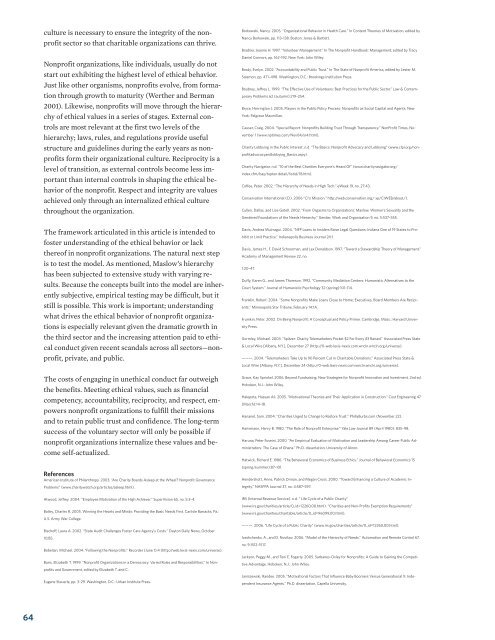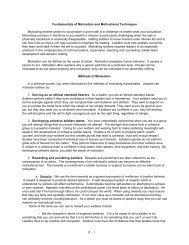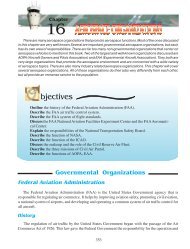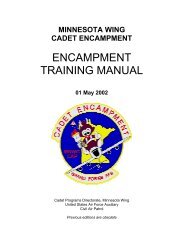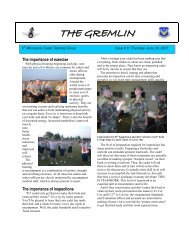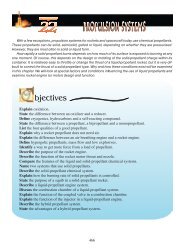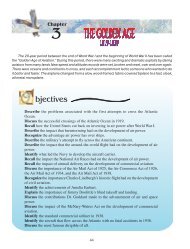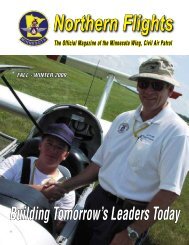culture is necessary to ensure the integrity of the nonprofitsector so that charitable organizations can thrive.Nonprofit organizations, like individuals, usually do notstart out exhibiting the highest level of ethical behavior.Just like other organisms, nonprofits evolve, from formationthrough growth to maturity (Werther and Berman2001). Likewise, nonprofits will move through the hierarchyof ethical values in a series of stages. External controlsare most relevant at the first two levels of thehierarchy; laws, rules, and regulations provide usefulstructure and guidelines during the early years as nonprofitsform their organizational culture. Reciprocity is alevel of transition, as external controls become less importantthan internal controls in shaping the ethical behaviorof the nonprofit. Respect and integrity are valuesachieved only through an internalized ethical culturethroughout the organization.The framework articulated in this article is intended tofoster understanding of the ethical behavior or lackthereof in nonprofit organizations. The natural next stepis to test the model. As mentioned, Maslow’s hierarchyhas been subjected to extensive study with varying results.Because the concepts built into the model are inherentlysubjective, empirical testing may be difficult, but itstill is possible. This work is important; understandingwhat drives the ethical behavior of nonprofit organizationsis especially relevant given the dramatic growth inthe third sector and the increasing attention paid to ethicalconduct given recent scandals across all sectors—nonprofit,private, and public.The costs of engaging in unethical conduct far outweighthe benefits. Meeting ethical values, such as financialcompetency, accountability, reciprocity, and respect, empowersnonprofit organizations to fulfill their missionsand to retain public trust and confidence. The long-termsuccess of the voluntary sector will only be possible ifnonprofit organizations internalize these values and becomeself-actualized.ReferencesAmerican Institute of Philanthropy. 2003. “Are Charity Boards Asleep at the Wheel? Nonprofit GovernanceProblems” (www.charitywatch.org/articles/asleep.html).Atwood, Jeffrey. 2004. “Employee Motivation of the High Achiever.” SuperVision 65, no. 5:3–4.Bailey, Charles R. 2005. Winning the Hearts and Minds: Providing the Basic Needs First. Carlisle Barracks, Pa.:U.S. Army War College.Bischoff, Laura A. 2002. “State Audit Challenges Foster Care Agency’s Costs.” Dayton Daily News, October10:B5.Bobelian, Michael. 2004. “Following the Nonprofits.” Recorder (June 1):4 (http://web.lexis-nexis.com/universe).Boris, Elizabeth T. 1999. “Nonprofit Organizations in a Democracy: Varied Roles and Responsibilities.” In Nonprofitsand Government, edited by Elizabeth T. and C.Eugene Steuerle, pp. 3–29. Washington, D.C.: Urban Institute Press.Borkowski, Nancy. 2005. “Organizational Behavior in Health Care.” In Content Theories of Motivation, edited byNancy Borkowski, pp. 113–138. Boston: Jones & Bartlett.Bradner, Jeanne H. 1997. “Volunteer Management.” In The Nonprofit Handbook: Management, edited by TracyDaniel Connors, pp. 162–192. New York: John Wiley.Brody, Evelyn. 2002. “Accountability and Public Trust.” In The State of Nonprofit America, edited by Lester M.Salamon, pp. 471–498. Washington, D.C.: Brookings Institution Press.Brudney, Jeffrey L. 1999. “The Effective Use of Volunteers: Best Practices for the Public Sector.” Law & ContemporaryProblems 62 (autumn):219–254.Bryce, Herrington J. 2005. Players in the Public Policy Process: Nonprofits as Social Capital and Agents. NewYork: Palgrave Macmillan.Causer, Craig. 2004. “Special Report: Nonprofits Building Trust Through Transparency.” NonProfit Times, November1 (www.nptimes.com/Nov04/sr4.html).Charity Lobbying in the Public Interest. n.d. “The Basics: Nonprofit Advocacy and Lobbying” (www.clpi.org/nonprofitadvocacyandlobbying_Basics.aspy).Charity Navigator. n.d. “10 of the Best Charities Everyone’s Heard Of” (www.charitynavigator.org/index.cfm/bay/topten.detail/listid/18.htm).Coffee, Peter. 2002. “The Hierarchy of Needs in High Tech.” eWeek 19, no. 27:43.Conservation International (CI). 2006 “CI’s Mission.” http://web.conservation.org/ xp/CIWEB/about/).Cullen, Dallas, and Lise Gotell. 2002. “From Orgasms to Organizations: Maslow, Women’s Sexuality and theGendered Foundations of the Needs Hierarchy.” Gender, Work and Organization 9, no. 5:537–555.Davis, Andrea Muirragui. 2004. “NFP Loans to Insiders Raise Legal Questions: Indiana One of 19 States to Prohibitor Limit Practice.” Indianapolis Business Journal 24:1.Davis, James H., F. David Schoorman, and Lex Donaldson. 1997. “Toward a Stewardship Theory of Management.”Academy of Management Review 22, no.1:20–47.Duffy, Karen G., and James Thomson. 1992. “Community Mediation Centers: Humanistic Alternatives to theCourt System.” Journal of Humanistic Psychology 32 (spring):101–114.Franklin, Robert. 2004. “Some Nonprofits Make Loans Close to Home; Executives, Board Members Are Recipients.”Minneapolis Star Tribune, February 14:1A.Frumkin, Peter. 2002. On Being Nonprofit: A Conceptual and Policy Primer. Cambridge, Mass.: Harvard UniversityPress.Gormley, Michael. 2003. “Spitzer: Charity Telemarketers Pocket $2 For Every $3 Raised.” Associated Press State& Local Wire [Albany, N.Y.], December 27 (http://0-web.lexis-nexis.com.wncln.wncln.org/universe).———. 2004. “Telemarketers Take Up to 90 Percent Cut in Charitable Donations.” Associated Press State &Local Wire [Albany, N.Y.], December 24 (http://0-web.lexis-nexis.com.wncln.wncln.org/universe).Grace, Kay Sprinkel. 2006. Beyond Fundraising: New Strategies for Nonprofit Innovation and Investment. 2nd ed.Hoboken, N.J.: John Wiley.Halepota, Hassan Ali. 2005. “Motivational Theories and Their Application in Construction.” Cost Engineering 47(March):14–18.Hananel, Sam. 2004. “Charities Urged to Change to Restore Trust.” PhillyBurbs.com (November 22).Hansmann, Henry B. 1980. “The Role of Nonprofit Enterprise.” Yale Law Journal 89 (April 1980): 835–98.Haruna, Peter Fuseini. 2000. “An Empirical Evaluation of Motivation and Leadership Among Career Public Administrators:The Case of Ghana.” Ph.D. dissertation, University of Akron.Hatwick, Richard E. 1986. “The Behavioral Economics of Business Ethics.” Journal of Behavioral Economics 15(spring/summer):87–101.Hendershott, Anne, Patrick Drinan, and Megan Cross. 2000. “Toward Enhancing a Culture of Academic Integrity.”NASPPA Journal 37, no. 4:587–597.IRS (Internal Revenue Service). n.d. “ Life Cycle of a Public Charity”(www.irs.gov/charities/article/0,,id=12260,00.html). “Charities and Non-Profits Exemption Requirements”(www.irs.gov/charities/charitable/article/0,,id=96099,00.html).———. 2006. “Life Cycle of a Public Charity” (www.irs.gov/charities/article/0,,id=12260,00.html).Ivashchenko, A., and D. Novikov. 2006. “Model of the Hierarchy of Needs.” Automation and Remote Control 67,no. 9:1512–1517.Jackson, Peggy M., and Toni E. Fogarty. 2005. Sarbanes-Oxley for Nonprofits: A Guide to Gaining the CompetitiveAdvantage. Hoboken, N.J.: John Wiley.Janiszewski, Randee. 2005. “Motivational Factors That Influence Baby Boomers Versus Generational X: IndependentInsurance Agents.” Ph.D. dissertation, Capella University.64
Jeavons, Thomas H. 2005. “Ethical Nonprofit Management.” In The Jossey-Bass Handbook of Nonprofit Leadershipand Management, 2nd ed., edited by Robert D. Herman and associates, pp. 204–229. San Francisco: JohnWiley.Johnson, Chip. 2004. “Watching the Police’s Watchdogs.” San Francisco Chronicle, August 13:B1.and Retention in Nonprofit Organizations.” In The Jossey-Bass Handbook of Nonprofit Leadership and Management,2nd ed., edited by Robert D. Herman and associates, pp. 623–659. San Francisco: John Wiley.Weiner, Stanley. 2003. “Proposed Legislation: Its Impact on Not-For-Profit Board Governance.” CPA Journal 73(November):56 ff. (http://web.lexis-nexis.com/universe/).Latham, Gary P., and Craig C. Pinder. 2005. “Work Motivation Theory and Research at the Dawn of the TwentyfirstCentury.” Annual Review of Psychology 56:485–516.Werther, William B., Jr., and Evan M. Berman. 2001. Third Sector Management: The Art of Managing NonprofitOrganizations. Washington, D.C.: Georgetown University Press.Lord, Robert L. 2002. “Traditional Motivation Theories and Older Engineers.” Engineering Management Journal14 (September):3–8.Wymer, Walter, Jr., Patricia Knowles, and Roger Gomes. 2006. Nonprofit Marketing: Marketing Management forCharitable and Nongovernmental Organizations. Thousand Oaks, Calif.: Sage.Macduff, Nancy. 2005. “Principles of Training for Volunteers and Employees.” In The Jossey-Bass Handbook ofNonprofit Leadership and Management, 2nd ed., edited by Robert D. Herman and associates, pp. 703–730. SanFrancisco: John Wiley.Young, Dennis R., and Lester Salamon. 2002. “Commercialization, Social Ventures, and For-Profit Competition.”In The State of Nonprofit America, edited by Lester M. Salamon, pp. 423–446. Washington, D.C.: Brookings InstitutionPress.Maslow, Abraham H. 1943. “A Theory of Human Motivation.” Psychological Review 50, no. 4:370–396.McCabe, D. L., and L. K. Trevino. 1996. “What We Know About Cheating in College.” Change 28, no. 1:28–34.McCurley, Stephen. 2005. “Keeping the Community Involved: Recruiting and Retaining Volunteers.” In TheJossey-Bass Handbook of Nonprofit Leadership and Management, 2nd ed., edited by Robert D. Herman and associates,pp. 587–622. San Francisco: John Wiley.NCF (National Christian Foundation). 2006. “Smart Christian Giving” (www.nationalchristian.com).Osborn, Claire. 2004. “Two Must Pay Charity $14 Million; Damages Are to Punish Former King Foundation Executivesfor Bloated Salaries, Credit Card Use.” Austin American-Statesman, June 15:B1.Ostrower, Francie, and Marla J. Bobowick. 2006. “Nonprofit Governance and the Sarbanes-Oxley Act”(www.boardsource.org/dl.asp?document_id=473).Owen, John R., III. 2003. “Keeping Nonprofits Clean; An Audit Committee Is Needed to Help the Board Do ItsJob Correctly.” Pittsburgh Post-Gazette, April 8:D2.Pisello, Tom. 2003. “Anticipating IT Needs in Pyramidal Steps.” Computerworld 37, no. 34:49.Rouse, Kimberly A. Gordon. 2004. “Beyond Maslow’s Hierarchy of Needs: What Do People Strive For?” PerformanceImprovement 43, no. 10:27–31.Salamon, Lester. 1995. Partners in Public Service. Baltimore: Johns Hopkins University Press.———. 2005. Johns Hopkins Nonprofit Listening Post Project: Nonprofit Financial Disclosure. Communiqué No.4 (www.jhu.edu/listeningpost/news/pdf/comm04.pdf).Salmon, Jacqueline L. 2004. “Nonprofit Endorsements Will Expand: Maryland Group to Certify Charities AcrossNation.” Washington Post, June 27:C01.Saltonstall, David, and Heidi Evans. 2004. “Hale House Chief Quits After 22 Months.” New York Daily News,March 31:32.Schmidt, Elizabeth. 2004. “How Ethical Is Your Nonprofit Organization?”(www.guidestar.org/news/features/ethics.jsp).ABOUT THE AUTHORSRuth Ann Strickland is a professor in the Political Scienceand Criminal Justice Department at Appalachian StateUniversity, teaching and conducting research on publicpersonnel administration, ethics in nonprofit management,and public policy analysis. She obtained her Ph.D. in politicalscience in 1989 at the University of South Carolina. She haspublished four books, nine book chapters, and more thantwenty peer-reviewed articles in a wide array of journals.Shannon K. Vaughan is an assistant professor and assistantM.P.A. director in the Political Science and Criminal JusticeDepartment at Appalachian State University, teaching andconducting research on not-for-profit organizations, ethics,and policy analysis. She obtained her Ph.D. in political sciencein 2004 at the University of Kentucky. Her field experienceincludes positions as a nonprofit executive director and as agrants specialist, where she prepared grant proposals thatgenerated more than $4.7 million for government and nonprofitorganizations.Schwing, Richard. 2002. “A Mental Model Proposed to Address the Sustainability and Terrorism Issues.” RiskAnalysis 22, no. 3:415–420.“Shelter’s Ex-Director Sentenced for Stealing.” 2002. Milwaukee Journal Sentinel October 25:09A.Sinclair, Matthew. 2004. “Nonprofit Whistleblowers Need Protection.” NonProfit Times(wwwnptimes.com/Jun04/npt1.html).Smucker, Bob. 1999. The Nonprofit Lobbying Guide. 2nd ed. Washington D.C.: Independent Sector.Soltz, Barbara A. Burgess. 1997. “The Board of Directors.” In The Nonprofit Handbook: Management, 2nd ed., editedby Tracy Daniel Connors, pp. 114–147. New York: John Wiley.From: Ruth Ann Strickland and Shannon K. Vaughan, “TheHierarchy of Ethical Values in Nonprofit Organizations: AFramework for an Ethical, Self-Actualized OrganizationCulture,” Public Integrity 10, no. 3 (2008): 233-251. Usedwith permission.Souccar, Miriam Kreinan. 2004. “Nonprofit Hails New Director for Hardy Children’s Charity; Will Help HaleHouse Rebuild After Scandal?” Crain’s New York Business, April 12:14.Stephens, Joe. 2004. “Overhaul of Nature Conservancy Urged: Report by Independent Panel Calls for GreaterOpenness.” Washington Post, March 31:A01.Strom, Stephanie. 2003. “Accountability; New Equation for Charities: More Money, Less Oversight.” New YorkTimes, November 17:F1.“Theft from Cancer Society Raises Several Questions.” 2000. Columbus Dispatch, July 25:8A.Tyler, J. Larry, and Errol L. Biggs. 2004. “Conflict of Interest: Strategies for Remaining ‘Purer Than Caesar’s Wife.’” Trustee 57 (March):22–26.Vigil, Jennifer. 2004. “$3.9 Million Spent Directly for Victims.” San Diego Union-Tribune, May 2 (http://signonsandiego.com/news/fires/20040502-9999-/lm2redfunds.html/).Watson, Charles T. 2000. “Accountability a Key Factor for Groups Soliciting Help.” Ventura County Star, July16:E06.Watson, Mary R., and Rikki Abzug. 2005. “Finding the Ones You Want, Keeping the Ones You Find: Recruitment65
- Page 1 and 2:
VOLUME FOUR STRATEGIC PERSPECTIVESL
- Page 3 and 4:
VOLUME FOUR STRATEGIC PERSPECTIVESL
- Page 5 and 6:
VOLUME FOUR STRATEGIC PERSPECTIVESL
- Page 7:
VOLUME FOUR STRATEGIC PERSPECTIVESL
- Page 10 and 11:
12CHAPTER 12INTRODUCTION TO STRATEG
- Page 12 and 13:
12.1 Strategic Leadership: Defining
- Page 14 and 15:
mandates or resolutions that would
- Page 16 and 17: and ambiguity, aspiring strategic l
- Page 18 and 19: 12.2 National Security StrategyThe
- Page 20 and 21: within our borders has always been
- Page 22 and 23: front common challenges like violen
- Page 24 and 25: and our strategy, not sector earmar
- Page 26 and 27: thinking about organizations. She m
- Page 28 and 29: A systemic approach to failure is m
- Page 30 and 31: The late W. T. Grant Company is a r
- Page 32 and 33: the resources - setting the directi
- Page 34 and 35: focal point for describing and inte
- Page 36 and 37: Consequently, we do not restrict th
- Page 38 and 39: paragraphs, Web pages, then edit an
- Page 40 and 41: Web, can be viewed as a CS attempt
- Page 42 and 43: How to evaluate users and contribut
- Page 44 and 45: 13CHAPTER 13LEADING PUBLIC &VOLUNTE
- Page 46 and 47: 13.1 Leadership for Volunteers:The
- Page 48 and 49: 13.2 Take Root: Volunteer Managemen
- Page 50 and 51: QualificationsClearly list educatio
- Page 52 and 53: and effectively track their volunte
- Page 54 and 55: • Understand rules for recognitio
- Page 56 and 57: • Send a birthday card.• Submit
- Page 58 and 59: and tested more than six decades af
- Page 60 and 61: specific interests of the donors, v
- Page 62 and 63: tain) tax-exempt status from the In
- Page 64 and 65: Smucker, 1999).The Internal Revenue
- Page 68 and 69: 13.4 The New Look of TransparencyBy
- Page 70 and 71: ees for a couple of reasons: One, i
- Page 72 and 73: 13.5 Public and Private Management:
- Page 74 and 75: TABLE 1:FUNCTIONS OF GENERAL MANAGE
- Page 76 and 77: 3. Career System. The model corpora
- Page 78 and 79: islative charter - the Clean Air Ac
- Page 80 and 81: In controlling performance, Chapin
- Page 82 and 83: 14CHAPTER 14AIRPOWER ASSTRATEGIC LA
- Page 84 and 85: 14.1 Strategic Air Power: Fulfillme
- Page 86 and 87: carry it out. Their daylight raids
- Page 88 and 89: you did not rely on strategic bombi
- Page 90 and 91: 14.2 Warden and the Air Corps Tacti
- Page 92 and 93: ecomes one of applying sufficient i
- Page 94 and 95: tification, and a Jominian claim to
- Page 96 and 97: courage the rapid and widespread ex
- Page 98 and 99: it to influence physical players in
- Page 100 and 101: 14.4 Basic Air Force DoctrineAF Doc
- Page 102 and 103: earthquake-stricken Haiti. The worl
- Page 104 and 105: perspective. Airmen do not divide u
- Page 106 and 107: Command and ControlCommand and cont
- Page 108 and 109: 14.5 Should the US Maintain the Nuc
- Page 110 and 111: form of human government.” 20 Dem
- Page 112 and 113: obtainable goal. See the Global Zer
- Page 114 and 115: 15CHAPTER 15ORGANIZATIONAL CULTURE
- Page 116 and 117:
15.1 Organizational CultureBy Doria
- Page 118 and 119:
Review. This action strives to unco
- Page 120 and 121:
gram will serve and then having the
- Page 122 and 123:
ticipating the changes being made b
- Page 124 and 125:
Many years of working with change p
- Page 126 and 127:
At the least, the areas of concern
- Page 128 and 129:
15.4 Developing an Innovative Cultu
- Page 130 and 131:
CONCLUDING THOUGHTSIn an ever-chang
- Page 132 and 133:
global issues. Businesses that poss
- Page 134 and 135:
— Sees the big picture—the shif
- Page 136 and 137:
16CHAPTER 16STRATEGIC COMMUNICATION
- Page 138 and 139:
16.1 Principles of Strategic Commun
- Page 140 and 141:
16.2 The Art of NegotiationBy Brend
- Page 142 and 143:
16.3 Negotiating Effectively Across
- Page 144 and 145:
hidden areas can act as cultural ho
- Page 146 and 147:
and four conflict styles. Hammer be
- Page 148 and 149:
maintaining the relationship. As th
- Page 150 and 151:
25 Mitchell R. Hammer, “Chapter 1
- Page 152 and 153:
tural, socioeconomic, and psycholog
- Page 154 and 155:
for the win-win," during which time
- Page 156 and 157:
interests and, at worst, as a gun s
- Page 158 and 159:
Public diplomacy is surely about mu
- Page 160 and 161:
But public diplomats do not have th
- Page 162 and 163:
Photo courtesy of the familyThe LEA
- Page 164:
THE CADET OATHI pledge that I will


